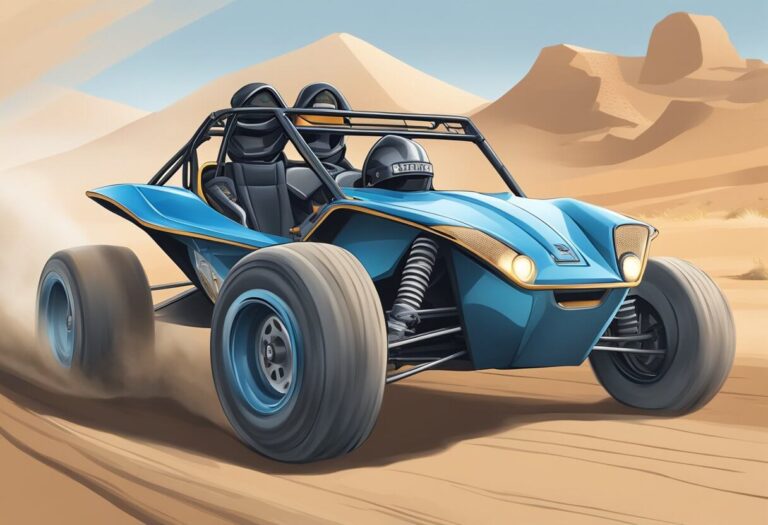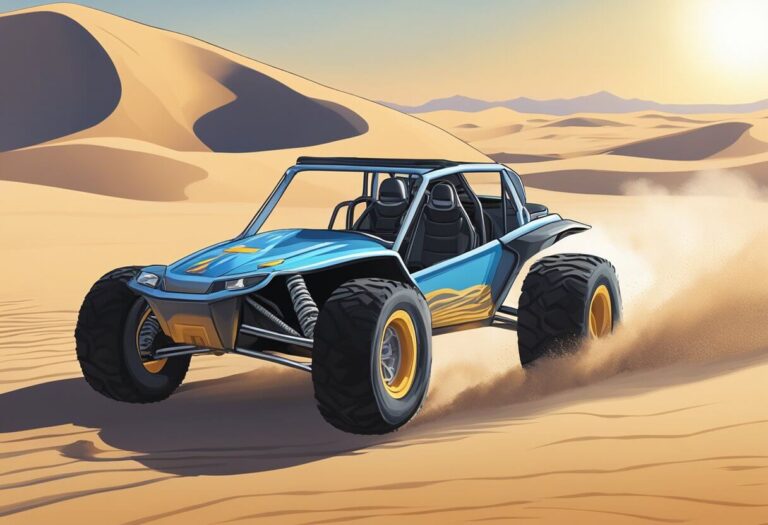Sand Dune Buggy: A Guide to Off-Roading Fun in the Desert

Sand dune buggies are recreational off-road vehicles that are designed to be driven on sand dunes, beaches, and other off-road terrains. They are typically topless vehicles with large wheels and wide tires, and are powered by rear-mounted engines. Sand dune buggies are often used for recreational purposes, such as exploring sand dunes and beaches, and participating in off-road races and events.
One of the key features of sand dune buggies is their ability to navigate through sand and other soft terrains. This is made possible by their large wheels and wide tires, which provide traction and stability on loose sand. Sand dune buggies are also designed to be lightweight and agile, which allows them to maneuver through tight spaces and over rough terrain with ease.
Sand dune buggies come in a variety of shapes and sizes, and can be customized to suit the needs of individual drivers. Some sand dune buggies are designed for speed and agility, while others are built for comfort and durability. Regardless of their design, sand dune buggies are a popular choice for off-road enthusiasts who enjoy exploring new terrains and pushing the limits of their vehicles.
History of Sand Dune Buggies

Sand dune buggies, also known as beach buggies, are recreational off-road vehicles designed for use on sand dunes, beaches, off-road or desert recreation. The design is usually a topless vehicle with a rear-mounted engine.
The origins of sand dune buggies can be traced back to the late 1940s when early beach and desert dwellers figured out that by stripping down an old jalopy and maybe throwing a bigger engine and larger tires on it, they could navigate the sandy terrain more easily.
In 1958, Pete Beiring of Oceano, California, took the body frame or “pan” from a damaged Volkswagen and shortened it into a new machine that eventually became the precursor to the dune buggy. This eventually led to the first production dune buggy called the “Sportster,” which was developed around 1960 by the EMPI Imp Company.
By the 1970s, the majority of VW-powered tubular chassis sand rails were created and constructed by their owners. Sand rails first appeared in the middle of the 1960s, and the first dune buggy known as the “Sportster” was built using Pete’s original design two years later, in 1960.
Today, sand dune buggies are a popular recreational vehicle, with many enthusiasts custom-building their own buggies or modifying existing vehicles. They are commonly used for racing and off-road adventures, and their unique design and capabilities make them a popular choice for those seeking an adrenaline rush.
Types of Sand Dune Buggies
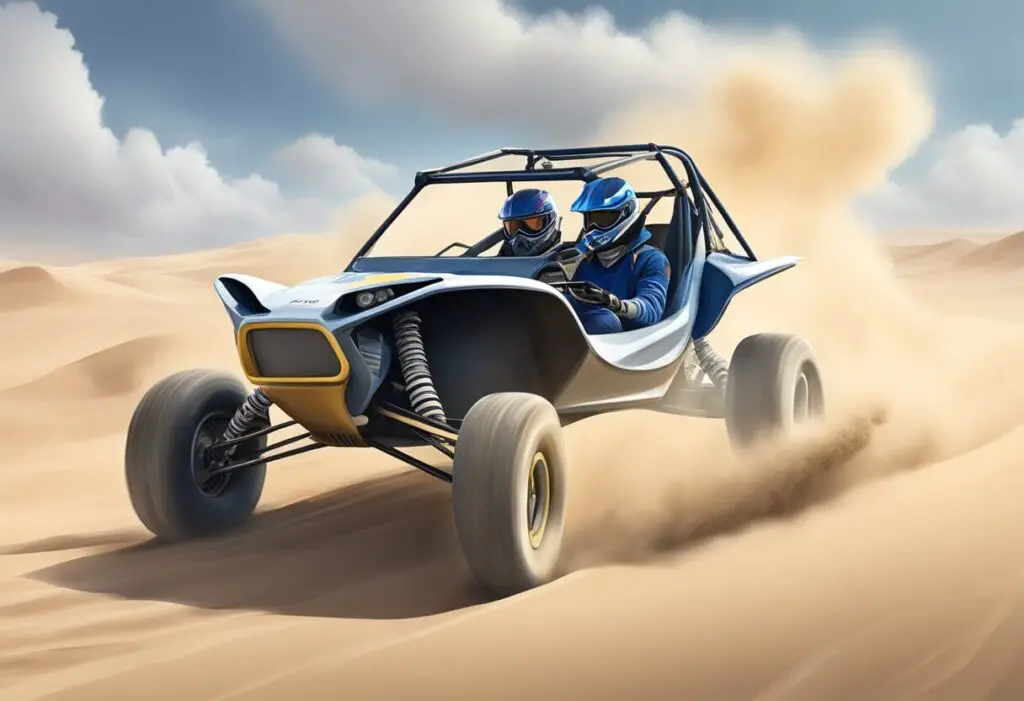
Sand dune buggies come in various types, each designed for a specific purpose. Here are the three main types of sand dune buggies:
Street Legal Buggies
Street legal buggies are designed for use on public roads and highways. They are typically equipped with headlights, taillights, turn signals, and other safety features required by law. These buggies are perfect for those who want to use their buggies as a daily driver or for cruising around town. They are also ideal for those who want to take their buggies on longer trips.
Off-Road Buggies
Off-road buggies are designed for use on sand dunes, beaches, and other off-road terrains. They are typically equipped with large wheels and wide tires that allow them to navigate through sand with ease. These buggies are perfect for those who want to explore the great outdoors and enjoy the thrill of off-road driving.
Racing Buggies
Racing buggies are designed for speed and performance. They are typically equipped with powerful engines, suspension systems, and other performance-enhancing features. These buggies are perfect for those who want to participate in off-road racing events or for those who simply enjoy the thrill of high-speed driving.
It’s important to choose the right type of sand dune buggy for your needs. Whether you’re looking for a street legal buggy, an off-road buggy, or a racing buggy, there’s a buggy out there that’s perfect for you.
Design and Construction
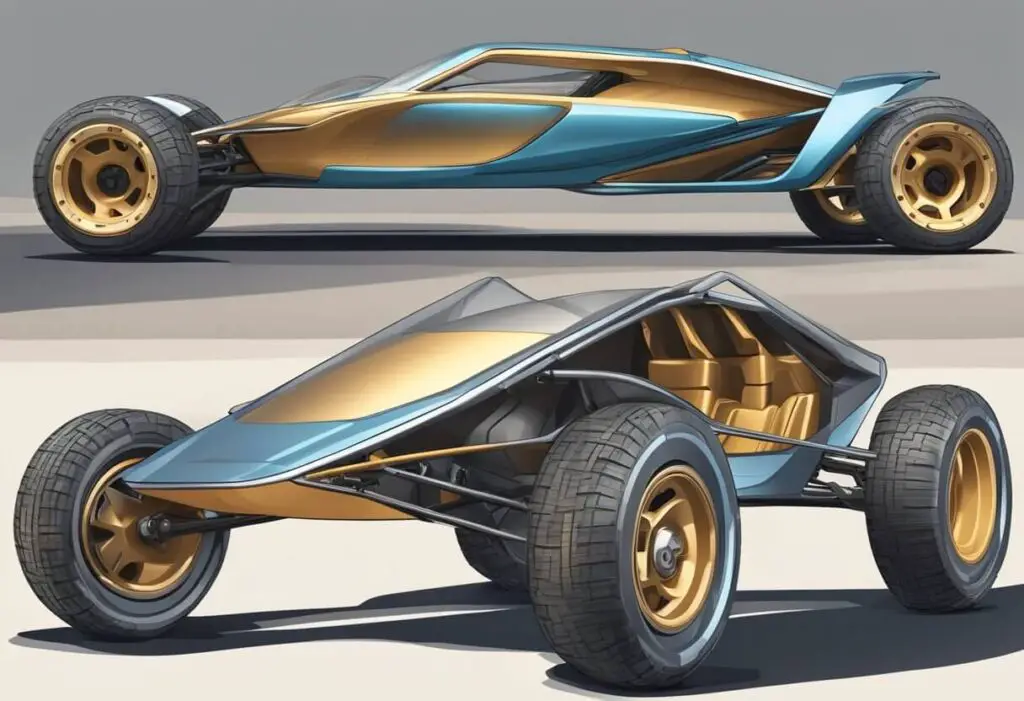
Chassis and Body
The chassis and body of a sand dune buggy are critical components that determine the vehicle’s overall performance and durability. A well-designed chassis should be strong, lightweight, and able to withstand the rigors of off-road driving. The body should be aerodynamic and provide ample space for the driver and passengers. Many sand dune buggies are built using a tube frame chassis, which is made from welded steel tubing. The body is typically made from fiberglass or aluminum, which is lightweight and easy to shape.
Engine and Transmission
The engine and transmission are the heart of any sand dune buggy. The engine should be powerful enough to provide ample torque and horsepower, but also reliable and easy to maintain. Many sand dune buggies use a Volkswagen air-cooled engine, which is lightweight, powerful, and easy to work on. The transmission should be strong and able to handle the torque and power of the engine. Many sand dune buggies use a four-speed manual transmission, which is simple and reliable.
Suspension and Tires
The suspension and tires are critical components that determine the vehicle’s handling and ride comfort. The suspension should be able to absorb the shock of off-road driving and provide ample ground clearance. Many sand dune buggies use a combination of coil-over shocks and torsion bars to provide a smooth ride. The tires should be able to provide ample traction on sand and other off-road surfaces. Many sand dune buggies use large, wide tires with aggressive tread patterns.
Safety Features
Safety is a critical consideration when designing and building a sand dune buggy. The vehicle should be equipped with a roll cage to protect the driver and passengers in the event of a rollover. The seats should be securely mounted and equipped with safety harnesses. The vehicle should also be equipped with headlights, taillights, turn signals, and brake lights to ensure visibility on public roads. Other safety features may include a fire extinguisher, first aid kit, and emergency supplies.
Performance and Handling
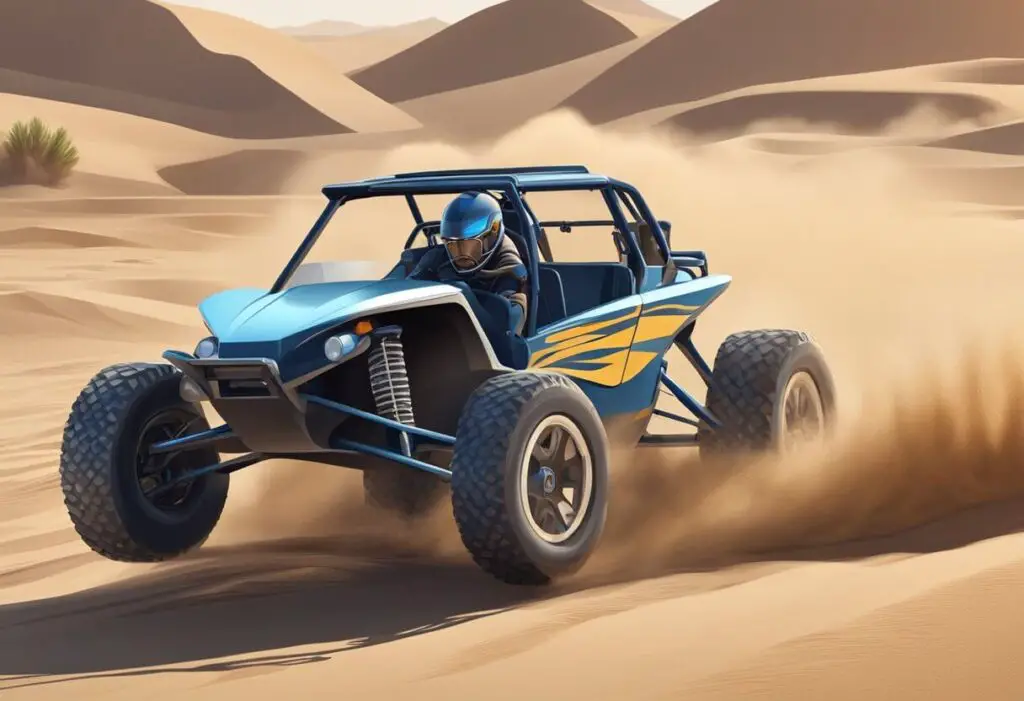
When it comes to sand dune buggies, performance and handling are key factors to consider. The best dune buggies have powerful engines, durable suspensions, and excellent handling capabilities.
One of the most important aspects of a sand dune buggy’s performance is its engine. A powerful engine is necessary to navigate the challenging terrain of sand dunes. The Joyner Sand Viper 1,100cc, for example, has an 86hp four-cylinder engine that can reach top speeds of around 70 miles per hour. The BMS Sand Sniper T-1500 4S also has a powerful engine, capable of reaching speeds of up to 60 miles per hour.
In addition to a powerful engine, a sand dune buggy also needs a durable suspension system. The suspension system must be able to absorb the shock of rough terrain and provide a smooth ride for the driver and passengers. The Meyers Manx, for example, has a custom-built suspension system that provides excellent handling and stability on sand dunes.
Handling is another important factor to consider when choosing a sand dune buggy. A buggy with good handling capabilities can navigate tight turns and steep inclines with ease. The Tatum Dragon Sand Car, for example, has a low center of gravity and a long wheelbase, which provides excellent stability and handling on sand dunes.
Regulations and Safety
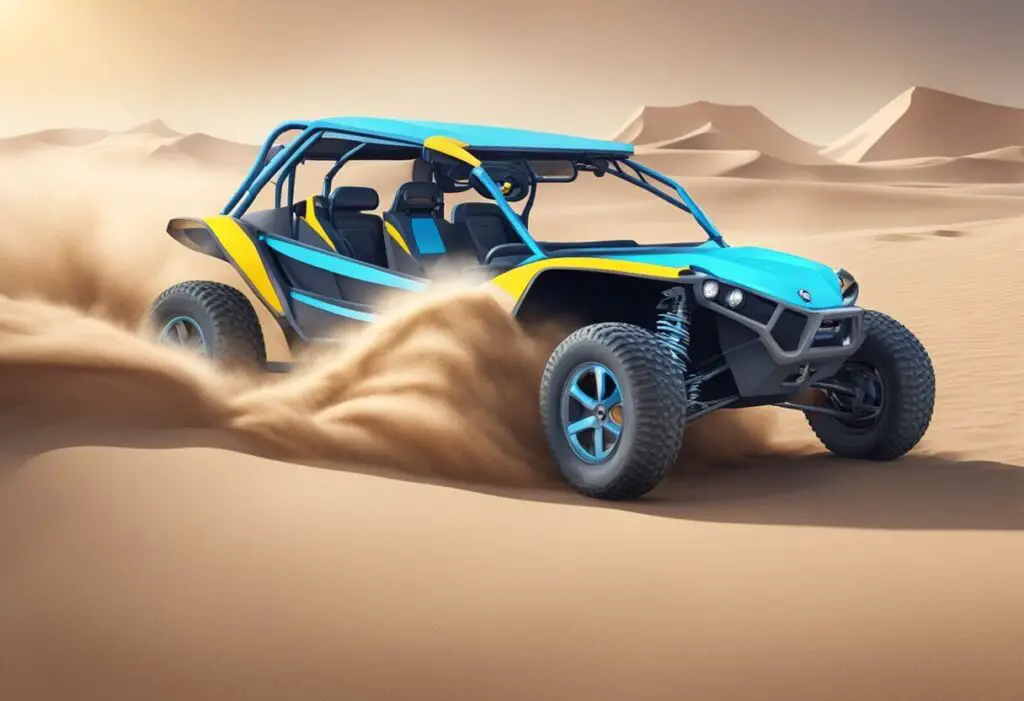
Environmental Regulations
Sand dune buggies are often used in areas with sensitive ecosystems, such as sand dunes and beaches. As such, there are a number of environmental regulations that must be followed when operating a sand dune buggy in these areas. These regulations are designed to protect the environment and prevent damage to fragile ecosystems.
One of the most important environmental regulations is the requirement to stay on designated trails. Driving off-trail can cause significant damage to the surrounding vegetation and wildlife, and can also contribute to erosion. In addition, sand dune buggies should be equipped with appropriate tires that are designed for use on sand and other soft surfaces. This can help to minimize the impact of the vehicle on the environment.
Safety Regulations
Safety is a top priority when operating a sand dune buggy. There are a number of safety regulations that must be followed in order to ensure the safety of the driver, passengers, and other individuals in the area.
One of the most important safety regulations is the requirement to wear appropriate safety gear, such as helmets and seat belts. This can help to prevent injuries in the event of an accident. In addition, sand dune buggies should be equipped with appropriate safety features, such as roll cages and fire extinguishers.
Permits and Licensing
In order to operate a sand dune buggy, it may be necessary to obtain permits and licenses from the appropriate authorities. The specific requirements for permits and licenses can vary depending on the location and intended use of the vehicle.
For example, in some areas, it may be necessary to obtain a permit in order to drive on designated trails. In addition, sand dune buggies may be subject to registration and licensing requirements, similar to other motor vehicles. It is important to check with the appropriate authorities to determine the specific requirements for operating a sand dune buggy in a particular area.
Popular Sand Dune Buggy Destinations

Sand dune buggies are off-road vehicles that are specially designed to navigate through sand dunes. They are popular among adventure seekers who love to explore the great outdoors. Here are some popular sand dune buggy destinations that offer thrilling experiences for riders.
Glamis, California
Glamis is a popular sand dune buggy destination located in southern California. It is home to the Imperial Sand Dunes, which is the largest sand dune system in California. The dunes stretch for over 40 miles and offer a variety of terrains for riders to explore. The area is open to off-road vehicles and has designated areas for camping.
Las Vegas, Nevada
Las Vegas is another popular destination for sand dune buggy enthusiasts. The city is surrounded by natural landscapes that offer a variety of terrains for riders to explore. The nearby Valley of Fire State Park is a popular destination for sand dune buggy rides. The park has over 40,000 acres of red sandstone formations, and riders can navigate through the canyons and valleys for a thrilling experience.
Oregon Dunes National Recreation Area
The Oregon Dunes National Recreation Area is located on the coast of Oregon and is home to over 40 square miles of coastal dunes. The tallest dune in the area is over 500 feet tall, making it a popular destination for sand dune buggy riders. The area is open to off-road vehicles and has designated areas for camping.
Dubai, United Arab Emirates
Dubai is a popular destination for adventure seekers, and sand dune buggy riding is no exception. The city is surrounded by sand dunes, and there are many tour operators that offer sand dune buggy rides. Riders can explore the desert landscapes and experience the thrill of riding over sand dunes.
Baja California, Mexico
Baja California is a popular destination for sand dune buggy riders. The area is home to the Baja 1000, an off-road race that takes place every year. The race covers over 1,000 miles of rugged terrain, including sand dunes. Riders can explore the area and experience the thrill of riding through the desert landscapes.
Maintenance and Care
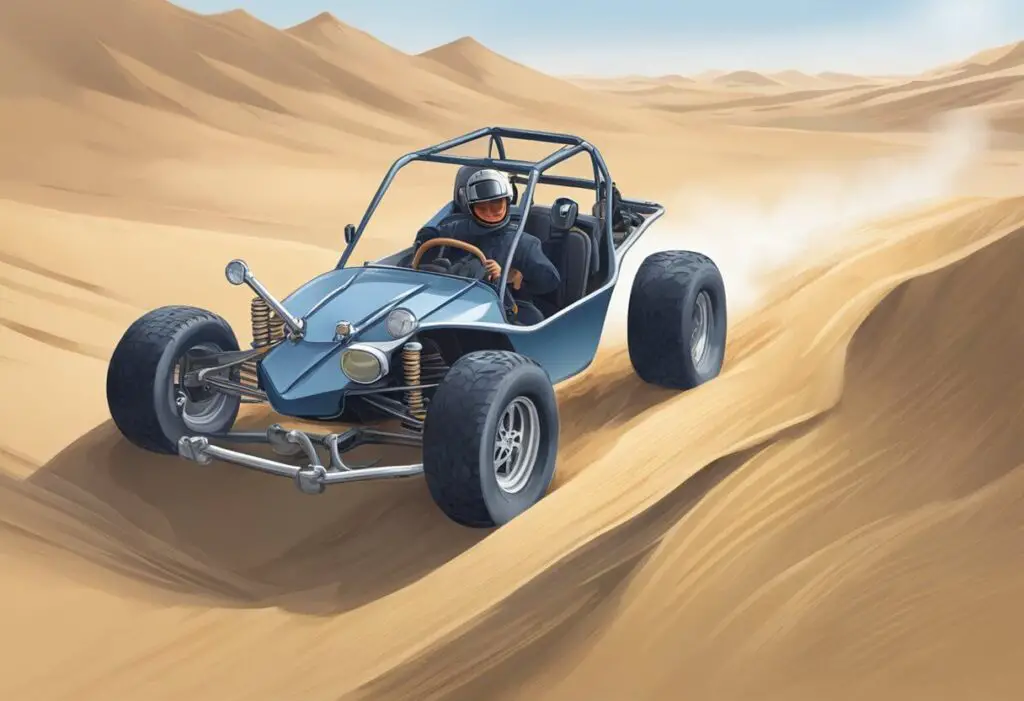
Maintaining a sand dune buggy is crucial to ensure it runs smoothly and efficiently. Regular maintenance and care not only extend the life of the vehicle, but also improve its performance.
Here are some tips for maintaining and caring for your sand dune buggy:
Regular Cleaning
Cleaning your sand dune buggy after every ride is important to prevent dust, sand, and dirt from accumulating and causing damage. Use a high-pressure hose or a bucket of water to clean the exterior of the vehicle. Use a soft-bristled brush to clean the wheels and undercarriage.
Check Fluid Levels
Check the fluid levels of your sand dune buggy regularly. This includes the engine oil, transmission fluid, brake fluid, and coolant. Top up the fluids as needed, and change them according to the manufacturer’s recommendations.
Inspect Tires
Inspect the tires of your sand dune buggy before and after every ride. Check for any signs of wear and tear, punctures, or cuts. Make sure the tires are properly inflated to the recommended pressure.
Lubricate Moving Parts
Lubricate the moving parts of your sand dune buggy regularly to prevent rust and corrosion. This includes the suspension components, steering components, and drivetrain. Use a high-quality lubricant that is recommended by the manufacturer.
Store Properly
Store your sand dune buggy in a dry and covered area to protect it from the elements. If you plan to store it for an extended period, remove the battery and store it separately. This will prevent the battery from discharging and potentially damaging the vehicle’s electrical system.
By following these maintenance and care tips, you can ensure your sand dune buggy remains in top condition for years to come.

